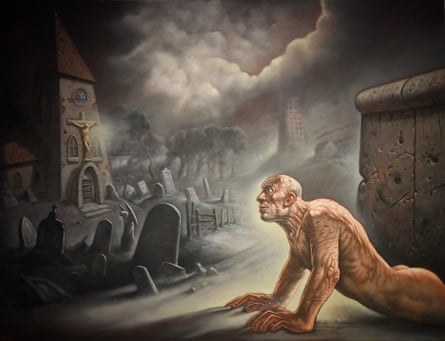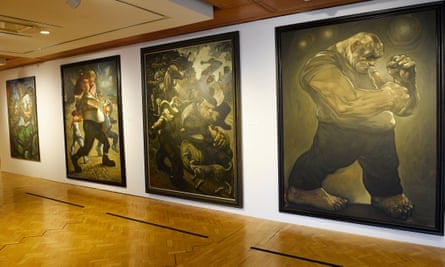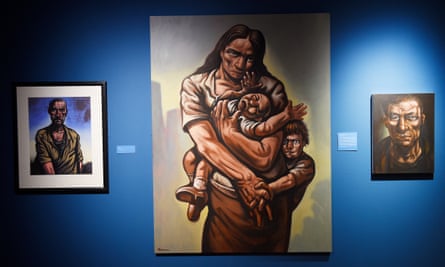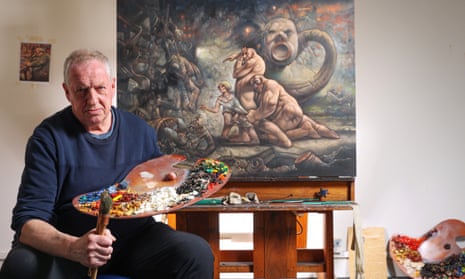‘It’s like seeing old friends again,” says Peter Howson, looking both pleased and perplexed as he rubs a thick hand across his face. He is not talking about people but canvases, the ones now being hung in an Edinburgh gallery for a retrospective to mark his 65th birthday that will bring together around 100 works spanning his career as one of Scotland’s leading figurative painters.
Howson is an artist renowned for capturing men at their most brutal extremes, from the hyper-muscled football hooligans of his early work to the flexing soldiers of Putin’s private army in recent paintings, prompted by the war in Ukraine. But in person he is the polar opposite: vulnerable, self-critical, an apologist for his own excesses. His friend, the painter John Bellany, once told him: “Me and you were like volcanoes, spewing out all this stuff. A lot of it’s rubbish and a lot of it’s quite good.”
He grins at the memory. “That’s the way I see myself, very prolific. I can’t stop working, I love what I do, it’s like I go into a different world. I’ve always loved it but more so now that I don’t have any kind of alcohol and drug problems.”
Howson’s life has been punctuated by years of chaotic addiction and immovable depression. Evident in his conversation is the infrastructure of sobriety: first, a religious faith that he says allows him to ascribe meaning to his suffering, as well as that of his subjects; second, a “very stabilising” relationship with his partner Lorraine, who he lives with in Glasgow’s West End; and third, the comfort of simple routine.

Routine is everything to him, “because of my condition” – Howson was also diagnosed with Asperger’s in his early 40s. He rises early, has his first cigarette of the day with a cup of tea, then sketches at home until 8 or 9am, when he goes to his studio near the Kingston Bridge to work on canvas, accompanied by his schnauzer, Buster. He exists in “self-imposed isolation” being “allergic to technology”: no mobile, emails or social media. “I keep on saying to my art dealer in London, ‘Will you write to me?’ But no one ever does.”
His work is infused with themes of conflict, destruction and redemption, the vehicle always being the male body. “I find it difficult to paint women or babies,” he admits. “I have done it but they generally look quite hard.”
The men that populate his work are in varying states of aggression or devastation: be that the pig-snouted, tight-vested thugs of Patriots, the swaggering caricature of The Noble Dosser, or the pained and sinewy Judas, part of an early 00s series based on his decline into and recovery from addiction.
Along with Ken Currie, Adrian Wiszniewski and Steven Campbell, Howson was part of the New Glasgow Boys, an influential group of artists who studied at the city’s art school in the 1980s. One might easily mistake his work for macho posturing, but when he sets out his motivation it becomes clear that it is as much about exorcising toxic masculinity.

“I was badly bullied at school,” he begins. “So those paintings came from anger originally, from wanting revenge. People think, because I paint those pictures, that I’m pro this macho-type thing, which I’m totally against. Having said that, there is a power about it you have to accept, and a danger, too.” The lure of machismo “almost destroyed me”, he says. “Because I felt so emasculated when I was young, I tried to build myself up: I became a bouncer, I joined the army. All these things that are really not me. People misunderstand the meaning: they think that I’m making [those men] into heroes, when it’s not that at all. It’s a contradiction: I’m trying to get power into my work at the same time as taking the mickey. But some of the Bosnian work is my freest.”
Howson was official war artist for the Imperial War Museum during the Bosnian war, an experience at once creatively lucrative and personally catastrophic. The horror of what he saw there, managed by top-up drinking, led to the collapse of his marriage, a breach with his only daughter, and ultimately a mental collapse requiring treatment for alcohol and cocaine addiction, then time in a psychiatric unit. And yet, as he acknowledges, it prompted some of his most powerful painting. At the time, his depiction of rape as a weapon of war, 1994’s Croatian and Muslim, painted from victims’ accounts, was considered controversial, and rejected by the museum that had commissioned him.
To coincide with the Edinburgh show, Flowers Gallery in London is bringing together a selection of Howson works from the 1980s to the present day. Five huge paintings bear witness to his long exploration of human violence and suffering, a result of his time in Bosnia but also the struggles of everyday life. In 1989’s The Psycho Squad, writhing, sinuous figures charge forth forcefully wielding flags, baseball bats and maces.
after newsletter promotion
Witnessing vicious conflict in Bosnia clearly had a lasting impact on Howson. “We were on a mission to pick up these Bosnian women and children, who had all been abused,” he recalls “That day changed my whole life. It changed my view of humanity, and I lost all hope for what people are. I remember picking up a young child, the look on its face, the smell. It had defecated and not been cleaned, while some of the women were banging their heads against brick walls.”
Intriguingly, Howson was treated with suspicion for centring victims’ experience back in the early 90s – two decades before #MeToo. “People were horrified,” he says, “especially the Imperial War Museum. I ended up having to go on to the radio and explain it. But then that thing happened with David Bowie buying the main painting. But things would be different now.”
Howson is referring to the fact that Bowie bought Croatian and Muslim and subsequently went on to sit for him on a number of occasions. He tosses in this mention of the singer – just one of his celebrity admirers, Madonna being another – with no obvious ego. He doesn’t feel part of any particular art scene these days. “It’s an old age thing,” he explains, but adds: “I do have trouble with a lot of conceptual art – I prefer to look at paintings, just really brilliant paintings.”

Howson’s Edinburgh retrospective will assemble works from public and private collections never previously viewed together, his graphic responses to recent global events, including the Covid pandemic and the war in Ukraine, as well as his religious works. Indeed, his first ever painting was of the crucifixion, at the age of six, although it’s moot whether it was God or gore that most attracted the young Howson: “The first drawings I did were people getting their heads and arms chopped off.”
Religion in art is unfashionable, he says, the response at exhibitions being “generally a groan”, though he doesn’t appear too bothered by it. His faith was reborn when he got sober: in the recovery community, he explains, rather than promoting a dogmatic version of faith, “you have to find a power higher than yourself”.
He still feels guilt over his behaviour towards loved ones when in the throes of addiction. “It lies heavy on me,” he says, in particular “abandoning” his seriously ill daughter, who was born with a hole in her heart and deprived of oxygen, then later diagnosed as autistic. Now aged 37, she’s a “fantastic” person but, he says, not an easy one to take care of, prone to bouts of violent anger. “And that’s a guilt as well, that I lose my temper with her sometimes.”
At the beginning of our conversation, Howson spoke about his drive to paint, his abandonment in the process. He will keep working, but feels “a hankering after a kind of peace”, he says. “That’s why I love Dante, the idea of him turning up at a monastery one day and the doors open and they say, ‘What do you want?’ And he says, ‘Peace.’ I can identify with that.”
Buster has just returned from a walk to the shops with Howson’s studio assistant, and arranges himself neatly on the floor to his master’s left, observing. Does he find some peace walking Buster? “I notice things like the trees and the flowers and the sky. I’m not distracted at all, but I do take it all in. The physical world is beautiful, you know?”
